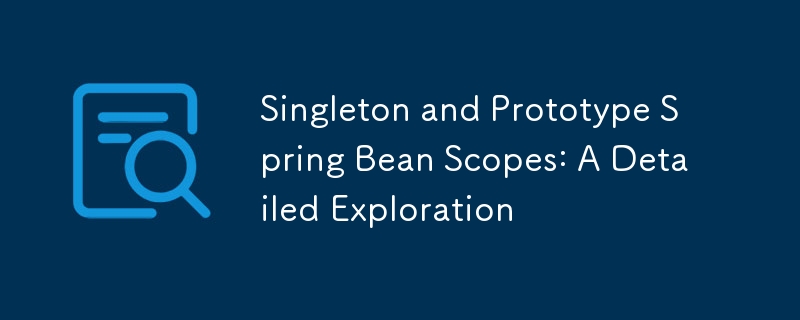

When I first started working with Spring, one of the concepts that intrigued me the most was the idea of bean scopes. Spring provides various bean scopes that determine the lifecycle of beans created within the Spring container. Two of the most commonly used scopes are Singleton and Prototype. Understanding these scopes is crucial for designing efficient and effective Spring applications, so let me walk you through what I’ve learned about them.
In Spring, a bean is an object that is instantiated, assembled, and managed by the Spring IoC (Inversion of Control) container. Bean scope refers to the lifecycle of the bean—how and when the bean instances are created, and how long they last.
Spring offers several bean scopes, but the two I’ll focus on are:
Each scope has its specific use cases, and choosing the right one can significantly impact the behavior and performance of your application.
The Singleton scope is the default scope in Spring, and it's the one I use most frequently. When a bean is defined with the Singleton scope, it means that the Spring container will create only one instance of that bean, and this single instance will be shared across the entire application context.
When I declare a bean as Singleton, Spring creates the bean instance the first time it is requested, either during the startup of the application context or when it is first referenced. After that, every subsequent request for this bean will return the same instance.
Here’s a simple example:
@Configuration
public class AppConfig {
@Bean
public MyService myService() {
return new MyService();
}
}
In this example, myService() is a Singleton bean. Every time I request a MyService bean from the Spring context, I’ll get the same instance.
I’ve found that the Singleton scope is ideal for stateless beans—those that do not hold any client-specific information. Examples include:
The major benefit of Singleton beans is memory efficiency. By reusing a single instance, the application consumes less memory and the overhead of creating and destroying objects is minimized. However, it’s important to be cautious with Singleton beans that maintain state. If a Singleton bean inadvertently holds state (e.g., instance variables), this state can be shared across multiple clients, leading to potential data inconsistencies.
In contrast to Singleton, the Prototype scope creates a new bean instance every time the bean is requested from the Spring container. When I learned about this, it was clear that Prototype beans are useful for scenarios where I need a fresh instance for each use.
When a bean is defined with the Prototype scope, Spring will return a new instance every time the bean is requested. Here’s how I might define a Prototype bean:
@Configuration
public class AppConfig {
@Bean
@Scope("prototype")
public MyService myService() {
return new MyService();
}
}
In this example, every time I request the MyService bean from the Spring context, Spring will create a new instance of MyService.
Prototype beans are particularly useful when dealing with stateful beans—those that maintain some sort of client-specific state or require unique configuration for each use. Some typical use cases include:
The primary advantage of using Prototype beans is the flexibility it offers in creating new instances. This is particularly useful when dealing with stateful objects. However, there’s a trade-off in terms of performance and resource usage. Since a new instance is created every time, it can lead to higher memory consumption and more frequent garbage collection. Moreover, unlike Singleton beans, Spring does not manage the lifecycle of Prototype beans beyond creation, so I have to handle the destruction and cleanup of these beans manually.
One of the key decisions I face when designing a Spring application is choosing between Singleton and Prototype scope. Here’s a summary of the factors I consider:
Let me provide a practical scenario that might help clarify when to use each scope. Suppose I’m building an online shopping application.
One thing I’ve learned the hard way is that mixing Singleton and Prototype beans can lead to unexpected issues. For example, injecting a Prototype-scoped bean into a Singleton bean can result in the Singleton bean always using the same instance of the Prototype bean. To avoid this, I usually inject a Provider or use the @Lookup annotation to ensure a new instance of the Prototype bean is created every time it is needed.
@Service
public class SingletonService {
@Autowired
private Provider<MyPrototypeService> myPrototypeServiceProvider;
public void usePrototypeService() {
MyPrototypeService prototypeService = myPrototypeServiceProvider.get();
prototypeService.execute();
}
}
In this example, myPrototypeServiceProvider.get() ensures that a new instance of MyPrototypeService is created every time it is called within the Singleton bean.
Understanding the nuances of Singleton and Prototype bean scopes in Spring has been critical in my journey as a developer. Both scopes offer distinct advantages depending on the use case, and choosing the right one can significantly impact the performance and design of an application.
In my experience, Singleton is the go-to scope for most beans due to its efficiency and simplicity, while Prototype is reserved for those special cases where I need a fresh instance every time. By carefully considering the statefulness of my beans and how they are used within the application, I can make informed decisions that lead to better, more maintainable Spring applications.
Das obige ist der detaillierte Inhalt vonSingleton- und Prototype-Spring-Bean-Scopes: Eine detaillierte Untersuchung. Für weitere Informationen folgen Sie bitte anderen verwandten Artikeln auf der PHP chinesischen Website!




